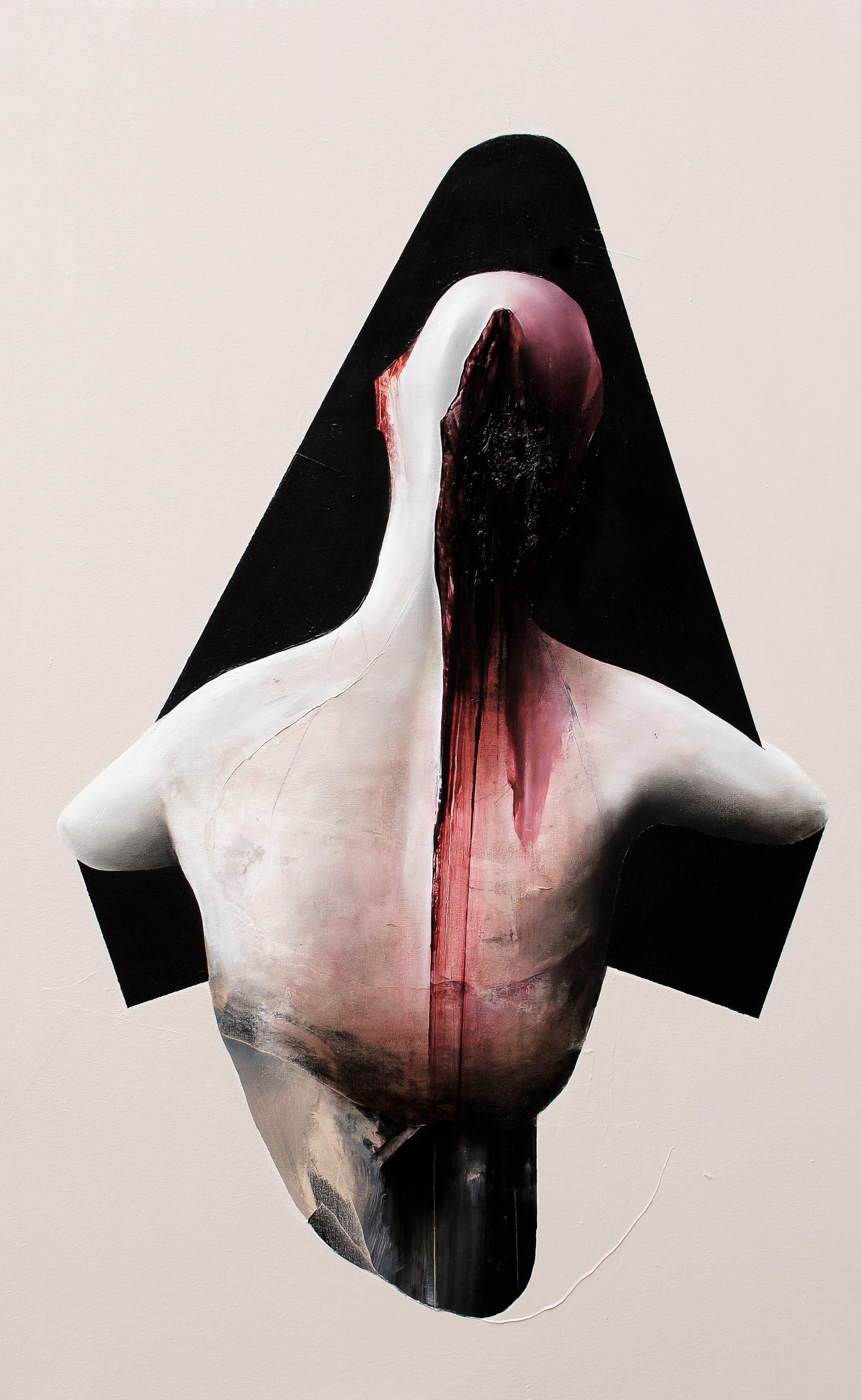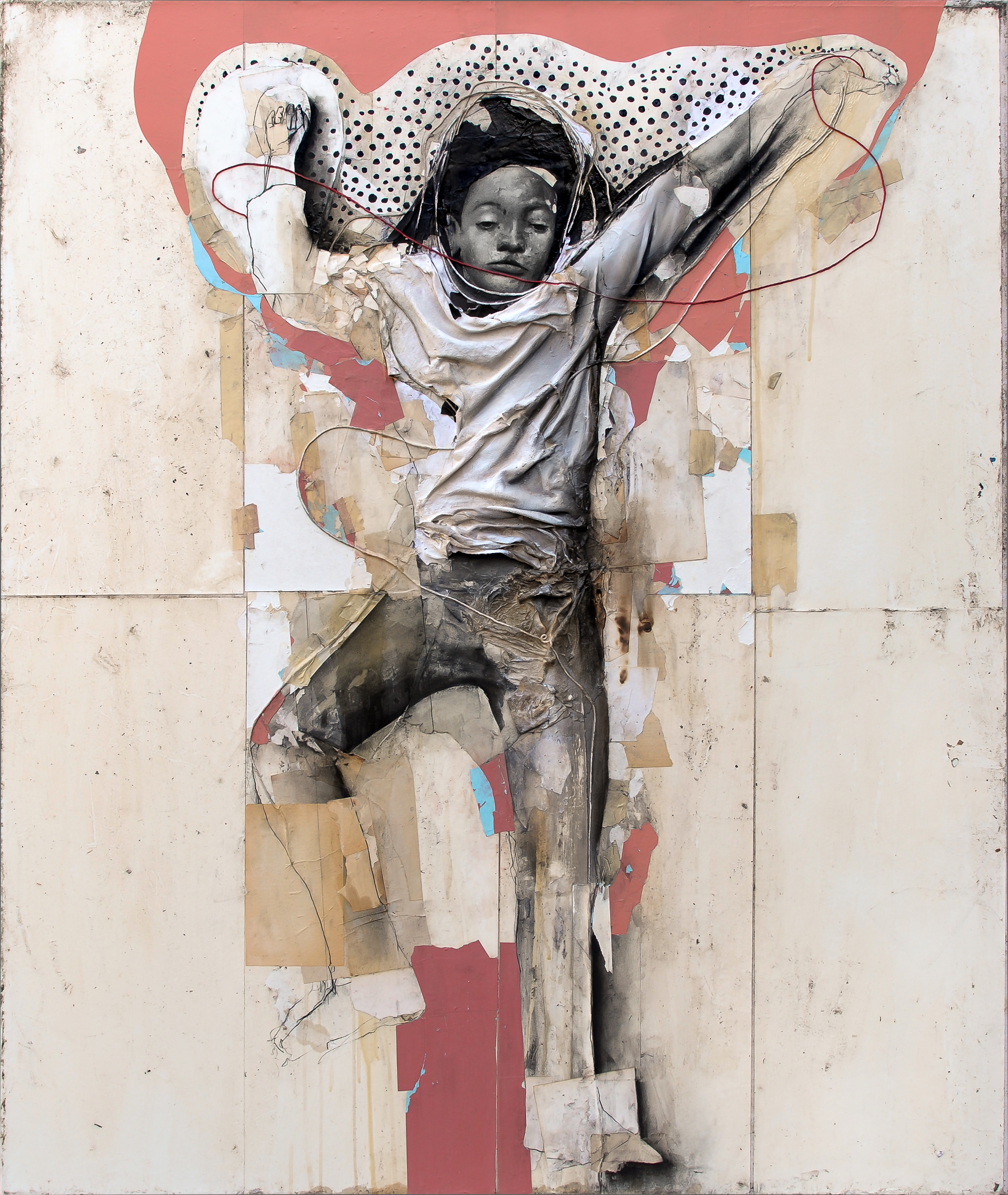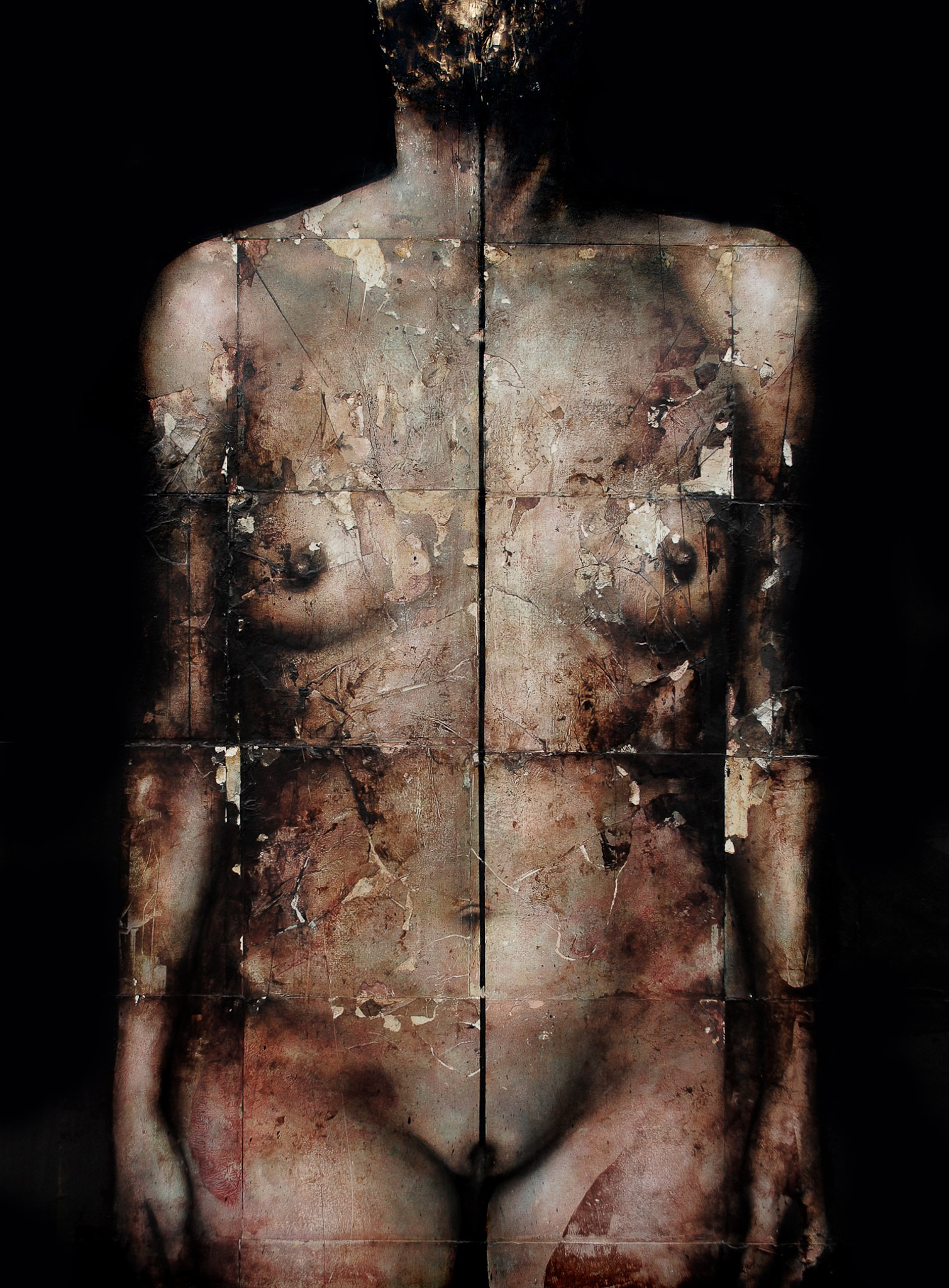Paul Cristina: In Consideration of Mortality
“Die not, poor Death, nor yet canst thou kill me.
From rest and sleep, which but thy pictures be,—“
Death, be not proud (Holy Sonnet 10)
John Donne, 1572 - 1631
Mary Shelley’s novel Frankenstein (1818) portrays an idealistic Dr. Frankenstein who unearths human remains to triumph over death. Paul Cristina’s collaged paintings of corpses make a distinct parallel to this fiction, pieced together and reanimated by the spirit of art while devoid of that spark of life that some would call a soul. Cristina explores the realm of the underworld like a modern Dante, giving insight into the abject reality of human existence—the finite nature of our corporeal vessels. Exhumed and resurrected, Cristina’s figures take on an eerie half-life that haunts the viewer long after they are exposed.
Cristina’s works have been exhibited by Last Rites Gallery as well as its affiliate Booth Gallery, both of which have a tendency to lean towards a dark and macabre aesthetic. Cristina has also gained a foothold in his adopted home of Charleston, South Carolina, receiving the First Place Prize for Fine Art and Drawing at the North Charleston Fine Arts Festival Juried Exhibition and exhibiting in three solo shows in the last three years.
Parallel Affections / We Are Demons. Charcoal, acrylic, oil, shellac, cloth and string on paper mounted to canvas. 2017.
Beginning with skillfully rendered portraits in charcoal, Cristina abuses and cannibalizes his efforts by tearing, cutting, distressing and reconstructing them, at times adding found print media and shellac to the mix. Held together by glue, they are painted onto and into in muted orange , pink and blue acrylic colors. Newer work incorporates ink dots, which read like markings of disease and red string that, as in Parallel Affections / We Are Demons (2017), serves as both hangman’s noose and umbilical cord. This process of deconstruction and repair seems both a struggle and a resolution in one. The result is a physical surface that speaks to the ephemeral materiality of our own bodies on a very visceral level.
Cristina was raised in a Catholic household and his collages are infused with ritualistic iconographic representation, with figures enshrouded in veils or arranged in a cruciform. The Catholic Church is rife with tales of the macabre. The lives of the saints are horrific. Saint Philomena was thrown in a dungeon, beaten and drowned. Saints Perpetua and Felicity were whipped then torn to pieces by a wild cow. Saint Agatha had her breasts cut off and was rolled in a bed of coals. Cristina’s post-mortem depictions of human suffering seem tame in comparison.
The construction of The Girl Who Thought She Was Christ (2017) portrays a young girl, arms splayed above her head, legs askew. Barely leaving any trace of recognizable human characteristics yet referential to the human form, Partial Crucifixion in an Attempt to Gain Momentary Approval from the Hemophiliac (2017) shows a torso, or what is left of it. The head is bludgeoned and oozing crimson paint with truncated arms outstretched in supplication. I rescind my earlier statement. Cristina’s artwork is equal to the tale of suffering endured by Catholic saints and more gruesome in that its humanity has been stripped away. As Julia Kristeva states in her essay on abjection Pouvoirs de l'horreur (Powers of Horror), “The corpse, seen without God and outside of science is the utmost of abjection. It is death infecting life.”(1) Without religion or even the misguided scientific impulse of Frankenstein, Cristina lifts the veil of denial that separates us from the reality that we are flesh, blood and bone, capable of and subject to the most primeval of impulses.
It’s not surprising to know that Francis Bacon is an important artist for Cristina. Bacon’s early painting, Crucifixion (1944) could easily be a reference for Cristina’s above mentioned Partial Crucifixion, though Bacon’s biomorphic form is more ghostly than gruesome. There is an animalistic, visceral quality that Cristina seems to be channeling from Bacon, whose imagery comes from physical abuse received in childhood and adulthood (the latter a sadomasochistic choice). Cristina sees these and other dark nights of the soul and psyche as simply another facet of human nature that must be embraced.
Cristina further pushes the borders of accepted mores and beliefs into the abject by sexualizing the corpse. Through Birth and Burial (2018), shows a woman whose head is wrapped in ceremonial rags, eyes closed, hands dangling. The portrait ends with her pubis exposed in stark contrast to her covered head. In The Division of the Body During Apostasy III (2016), an unidentified woman’s body is exposed and bisected by a median line that ends at her naked sex. The image is covered in rips, tears and more crimson washes.
Kristeva describes abjection as preserving “what existed in the archaism of pre-objectal relationship, in the immemorial violence with which a body becomes separated from another body in order to be—maintaining that night in which the outline of the signified thing vanishes and where only the imponderable affect is carried out."(1) This reference to the loss of connection to the mother as an integral cog in the wheel of abjection makes me wonder if the exposure of the sex of the corpse in Cristina’s work is not a sign of a repressed Oedipal complex.
Creating an erotic representation of the remains of the dead is fraught with Freudian implications not to mention possible interpretations of the work as a sign of necrophilia (from Greek necro-death and philia-affection meaning sexual attraction to corpses). The psychological phenomenon of necrophilia is described by Austro–German psychiatrist Richard von Krafft-Ebing, in his 1894 publication Psychopathia Sexualis, as a manifestation of sadism. Necrophilia can be separated into three types under the classification of Genuine necrophilia, according to Jonathan P. Rossman, MD and Phillip J. Resnick, MD: Necrophilic homicide, Regular necrophilia, and Necrophilic fantasy. The third type is defined as “fantasizing about sexual activity with a corpse, without carrying out any necrophilic acts”. Though only a few of Cristina’s works fall under this possible interpretation, the implications are still disturbing and heighten the experience of abjection.
Through the medium of collage Cristina is able to share in experiences outside the social norm and, in theory, exorcise his demons, conscious and unconscious. Facing our own mortality in this raw unfiltered exposure of the corpse is beyond the tolerance of the human psyche. We, the viewers, are given a voyeuristic opportunity to vicariously experience something too powerful to process in reality. Cristina has exhumed our most primal fears and exposed them in uncanny spectacle. It cannot be unseen.
1) Kristeva, J. 1983. Pouvoirs de l'horreur. [Paris]: Seuil.
2) Rossman MD and Resnick MD, 1989. Sexual Attraction to Corpses: A Psychiatric Review of Necrophilia, Bull Am Acad Psychiatry Law, Vol. 17, No. 2.




